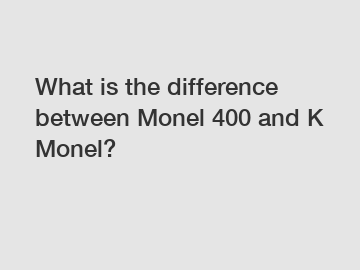What is the difference between Monel 400 and K Monel?
What is the difference between Monel 400 and K Monel? Monel 400 and K Monel are both nickel-copper alloys that offer excellent corrosion resistance in various environments. However, they differ in terms of composition and applications, leading to distinct characteristics and performance.
Monel 400, also known as alloy 400, is composed of approximately 67% nickel and 23% copper, with small amounts of iron, manganese, carbon, and silicon. It is known for its high strength and resistance to acids, alkalis, and seawater, making it ideal for marine and chemical processing applications. Monel 400 is highly resistant to stress corrosion cracking and has good thermal conductivity. Additionally, it retains its mechanical properties at sub-zero temperatures, which is advantageous in cryogenic applications. Due to its excellent properties, Monel 400 is commonly used in industries such as oil and gas, marine engineering, and chemical processing.
On the other hand, K Monel, also referred to as Monel K-500 or alloy K-500, is an age-hardened version of Monel 400. It contains approximately 63% nickel, 30% copper, 2.5% aluminum, and smaller quantities of titanium and iron. The addition of aluminum and titanium enhances the alloy's strength and hardness, while still maintaining its superior corrosion resistance. K Monel offers higher mechanical properties than Monel 400, especially in terms of tensile strength and hardness. It exhibits excellent resistance to saltwater corrosion and is widely used in marine applications such as propeller shafts, pump shafts, and valve components.

The difference in composition between Monel 400 and K Monel directly affects their respective performance and applications. While Monel 400 is favored for its exceptional resistance to various corrosive environments, K Monel provides improved strength and hardness, making it suitable for more demanding applications where higher mechanical properties are required. Choosing between the two alloys depends on the specific requirements of the intended application.
Moreover, the selection of the appropriate alloy can have significant implications in terms of cost-effectiveness and longevity. For instance, using Monel 400 in an application that requires the higher strength of K Monel would lead to premature failure. On the other hand, incorporating K Monel where Monel 400 would suffice may result in unnecessary expenses. Therefore, understanding the differences between these alloys and their respective capabilities is essential for making informed decisions in various industries.
In conclusion, Monel 400 and K Monel are nickel-copper alloys with distinct compositions, resulting in different mechanical properties and application suitability. While Monel 400 offers excellent corrosion resistance and mechanical properties, K Monel provides enhanced strength and hardness. The choice between these alloys depends on the specific requirements of the intended application, and understanding their differences is crucial for achieving optimal performance and cost-effectiveness.
If you want to learn more, please visit our website Nickel-Chromium Woven Mesh, pure Platinum Wire Mesh, Durable Monel Alloy Wire Mesh.
264
0
0

Comments
All Comments (0)